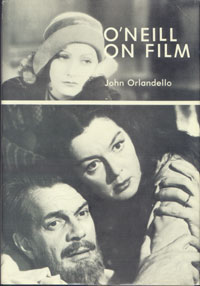|
There is
no other American writer whom Hollywood has adapted as
often and as thoroughly as Eugene O'Neill. Which is
small wonder, since his plays have run so often and so
long on Broadway, and filmland, by far the junior
medium, has always been in awe of its elder,
"legitimate" cousin. So a book on the movie versions of
O'Neill's plays was definitely in order, and John
Orlandello, whose respect and affection for the master
dramatist are apparent throughout, covers their first
half century in marvelous detail.
The
succinct introduction makes it clear that the author is
well-versed in the contrasting techniques of stage and
screen and is free of any rigid viewpoint about how best
to effect transference from the former realm to the
latter: "it seems impossible," he writes, "to insist on
a single model for effectiveness in adapting stage works
to the screen" (p. 14). Accordingly, he offers no
wholesale endorsement of the general feeling "that film
versions of plays must 'open up' the stage work," but he
does insist that filmed plays "remain ... faithful to
the spirit of the work on which they are based" (p. 15).
The
fascination of the book is really twofold: (1) its
painstaking study of the minutiae in the eleven screen
versions of twelve O'Neill plays (twelve, since Anna
Christie and Ah, Wilderness! were both
cinematized twice, but one film, The Long Voyage Home,
combined the contents of four of the one-act sea plays);
and (2) its grand overview of fifty years of Hollywood
evolution—the advent of sound, changing trends in public
taste, censorship's dominating fist, the star system,
and technical advances in the medium itself. Some will
value the book for its thirty-five clear and well-chosen
illustrations from the films discussed; others for its
detailed filmography; others for its study of O'Neill's
changing attitudes (mostly downward) toward motion
pictures; and others for the grist it provides for the
currently popular trivia mill. What, for instance, would
have been the result if Greta Garbo and Katharine
Hepburn had played mother and daughter in Mourning
Becomes Electra? (Theresa Helburn had suggested
Hepburn for Lavinia, and O'Neill liked the idea, but
Louis B. Mayer's "Over my dead body" torpedoed the plan;
and Garbo, offered the role of Christine, refused to
come out of retirement.) Of such what-ifs are
film-lovers' dreams woven! Equally interesting as a
tangential tidbit is the story of the rediscovery of the
earlier Anna Christie (1923), starring Blanche
Sweet. The first film version of an O'Neill play, and a
towering success with public and critics alike, it
dropped from sight and was feared lost forever until the
Museum of Modern Art learned of its presence in a Soviet
archive, acquired a print, and had its Serbo-Croatian
titles translated back into English. So all the O'Neill
films are now availablc—except for one, which will be
mentioned later.
In his
capsule descriptions of the original plays, Orlandello
says nothing new, generally settling for pat phrases
that make O'Neill sound simpler than he is; but his film
analyses, rich in detail, make one eager to see the
pictures again, even the bad
ones. In comparing the two Anna Christies, he
points out how much more faithful to the play the first
is, because of the "concession to morality" and the
softening of the characters in the more famous Garbo
version. Strange Interlude, though it seems ideal
for the screen, if only for the movies' voice-over
capability, fails because Robert Z. Leonard's screenplay
"strips the play of most of its complexity, its
reverberation of themes [one of those aforementioned pat
phrases], and most of its poetry" (p. 39). (Page 43's
act-by-act list of deletions is startlingly long; even
the title phrase, originally spoken by Nina, bit the
California dust!) The Emperor Jones also pales
beside its source, because a tight, expressionistic
narrative becomes a ten-year realistic one—a ponderous
dog whose tail (O'Neill's own play, tacked on at the
end) refuses to wag. Each film is afforded careful
scrutiny production details, individual performances,
camera work, etc.—the only omission being the William
Bendix-Susan Hayward Hairy Ape, which Orlandello
could not assess "since the film is currently
unavailable through either film archives or film
rental." Aside from the first Anna Christie, the
best adaptations are shown to be Long Day's Journey
Into Night (an example of the wisdom in not "opening
up" some plays for the screen), The Iceman Cometh
(because of the ensemble performance of a superb
cast—even Lee Marvin, whom the author defends at length
against the almost unanimous panning of the critics),
and, above all, The Long Voyage Home. O'Neill
called it "the best picture made from my stuff," and
Orlandello agrees, attributing much of its success to
the brilliant direction of John Ford: "O'Neill was
obsessed with the profound poetry of the sea, in both
its romantic and its brutal aspects, and Ford's film
captures these qualities both verbally and visually" (p.
101).
O'Neill on Film may not satisfy a long-felt need,
and it adds nothing to previous critical commentary on
the plays, but it deserves a place in any library whose
collections include the history of American cinema, and
O'Neill aficionados will find much to enjoy, especially
those who will be attending the O'Neill film festival at
the Boston conference next March. (And there's no
question about who wrote those last words!)
—Gerald Dorset and Frederick Wilkins,
The Eugene O'Neill Newsletter, 1983 |
![]()
